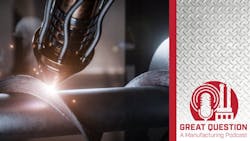Podcast: Additive succeeds when 'no one cares the part they're holding is 3D printed'
What you'll learn:
- Additive manufacturing is changing across sectors as innovation continues.
- Smart Industry’s Scott Achelpohl spoke with Ben Wynne, CTO of Intrepid Automation, to discuss additive manufacturing's role in U.S. manufacturing and as a major part of innovation across five sectors.
- Intrepid works with companies with its modular, industrial-scale additive manufacturing systems to benefit them across sectors
Smart Industry from time to time has reported for our audience on additive manufacturing’s utility—and we chose this podcast to focus on industrial 3D printing's value in the aerospace, defense, automotive, health care, and semiconductor production sectors specifically.
In this conversation, Head of Content Scott Achelpohl spoke with Intrepid Automation CTO Ben Wynne about how AM is distinguishing itself in these verticals and the application of additive technology itself.
See also: Podcast: Do manufacturers dream of 'digital workers'?
The conversation addressed the shifting application of AM across industries and how Intrepid Automation addresses those; which sectors show the most promise; and why additive has failed to penetrate the broader manufacturing industry.
Wynne detailed how additive is evolving in those sectors as needs change on a global scale—for example, in aerospace, how unmanned aerial vehicles, drones and other weapons have changed during the war between Ukraine and Russia, creating a shift in AM processes specifically for the defense industry.
Intrepid Automation, which creates modular, industrial-scale additive manufacturing systems (as in industrial 3D printing) for high-volume production, using a patented DLP (or Digital Light Processing) build process, works with companies to sell “holistic” solutions, Wynne said, collaborating with them to apply technology to solve core manufacturing problems.
Smart Industry presents this detailed and expansive conversation as an episode of Great Question: A Manufacturing Podcast.
Below is an excerpt from the podcast:
About the Podcast
Great Question: A Manufacturing Podcast offers news and information for the people who make, store, and move things and those who manage and maintain the facilities where that work gets done. Manufacturers from chemical producers to automakers to machine shops can listen for critical insights into the technologies, economic conditions, and best practices that can influence how to best run facilities to reach operational excellence.
[Scott Achelpohl] Where of the five we mentioned, aerospace, defense, automotive, health care, and semiconductors, is additive showing the most promise? Does any vertical stand out right now?
[Ben Wynne] If you look at these five and all these other things that we've seen in the kind of hype or media kind of the last couple of decades around additive, is that additive is not one thing. It has its own Gartner hype cycle. It's many dots from bioprinting to things that we're familiar with, printing at home, etc., which was completely foreign in the early 2000s.
I think if you look at—let's go through the industries one by one. So, if you look at Your first one is aerospace. I think what we're seeing is we're seeing war is changing. You look at things like the war in Ukraine and how much UAVs and drones are changing the theater of war, how quickly that technology is evolving as both the weapons and the countermeasures to those weapons are created.
There's a massive need for speed and iteration as both sides are kind of trying to find a new way of doing things to kind of improve their outcomes. I think if you compare that with the kind of legacy way that defense programs are run or spare parts and part production is done.
See also: Additive business sees more movement as Caracol acquires Weber assets
[SA] Does Intrepid utilize such software on behalf of its customers to predict the efficacy of a part before it gets installed to, say, a guided missile? Again, does Intrepid utilize such software on behalf of its customers?
[BW] If you take additive out of the equation and look at conventional manufacturing, these are the staples of quality systems, yield optimization, highly regulated spaces like medical and aerospace, they already have to do as much as they can to understand how these parts will function when they're produced.
See also: IFS debuts package of ‘digital workers’ in next iteration of agentic AI industrial software
I think the elephant in the room with additive is that you buy one printer, classically, you buy one printer, you can get it dialed in to make the part that you want, you now want to increase your capacity. You spend the money, you buy a second printer, and more often than not, that second printer does not make the same part as the first part that you created. So in my experience working with aerospace and defense companies in the past, you have maybe in excess of 100 or 200 industrial 3D printing machines.
[SA] Why has additive failed to penetrate the broader manufacturing industry?
[BW] That's a multibillion-dollar question. I think it's kind of touched on some of these points already. It's a lack of intent and it's a lack of, I suppose, focus. When you're trying to be everything to everybody, that's the hardest thing to solve. You become a jack of all trades and a master of none.
See also: What manufacturers risk when they try to patch everything
Our approach has been very focused. We look at instances where additive has penetrated. There are some very specific aerospace applications, whereas, as I say, many hundreds of machines are being used to make one part.
About the Author
Sarah Mattalian
Staff Writer
Sarah Mattalian is a Chicago-based journalist writing for Smart Industry and Automation World, two brands of Endeavor Business Media, covering industry trends and manufacturing technology. In 2025, she graduated with a master's degree in journalism from Northwestern University's Medill School of Journalism, specializing in health, environment and science reporting. She does freelance work as well, covering public health and the environment in Chicagoland and in the Midwest. Her work has appeared in Inside Climate News, Inside Washington Publishers, NBC4 in Washington, D.C., The Durango Herald and North Jersey Daily News. She has a translation certificate in Spanish.

